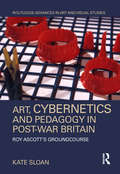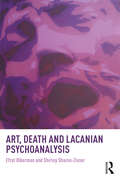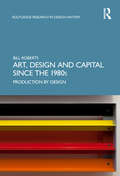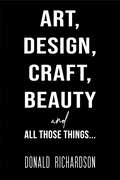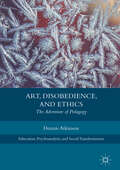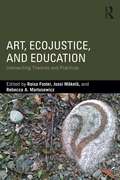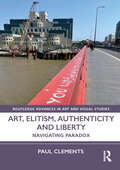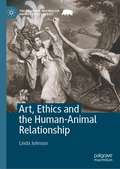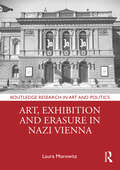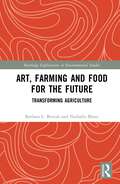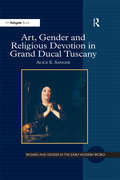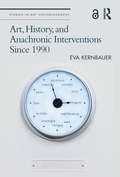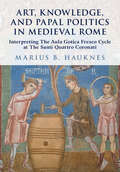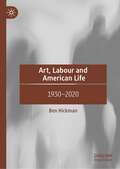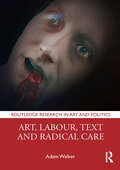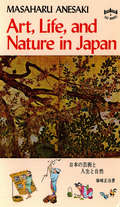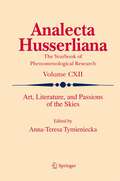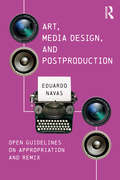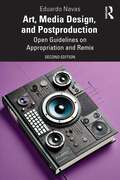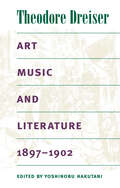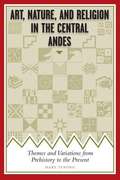- Table View
- List View
Art, Cybernetics and Pedagogy in Post-War Britain: Roy Ascott’s Groundcourse (Routledge Advances in Art and Visual Studies)
by Kate SloanThis is the first full-length study about the British artist Roy Ascott, one of the first cybernetic artists, with a career spanning seven decades to date. The book focuses on his early career, exploring the evolution of his early interests in communication in the context of the rich overlaps between art, science and engineering in Britain during the 1950s and 1960s. The first part of the book looks at Ascott’s training and early work. The second park looks solely at Groundcourse, Ascott’s extraordinary pedagogical model for visual arts and cybernetics which used an integrative and systems-based model, drawing in behaviourism, analogue machines, performance and games. Using hitherto unpublished photographs and documents, this book will establish a more prominent place for cybernetics in post-war British art.
Art, Death and Lacanian Psychoanalysis
by Efrat Biberman Shirley Sharon-ZisserArt, Death and Lacanian Psychoanalysis examines the relationship between art and death from the perspective of Lacanian psychoanalysis. It takes a unique approach to the topic by making explicit reference to the death drive as manifest in theories of art and in artworks. Freud’s treatment of death focuses not on the moment of biological extinction but on the recurrent moments in life which he called "the death drive" or the "compulsion to repeat": the return precisely of what is most unbearable for the subject. Surprisingly, in some of its manifestations, this painful repetition turns out to be invigorating. It is this invigorating repetition that is the main concern of this book, which demonstrates the presence of its manifestations in painting and literature and in the theoretical discourse concerning them from the dawn of Western culture to the present. After unfolding the psychoanalytical and philosophical underpinnings for the return of the death drive as invigorating repetition in the sphere of the arts, the authors examine various aspects of this repetition through the works of Gerhard Richter, Jeff Wall, and contemporary Israeli artists Deganit Berest and Yitzhak Livneh, as well as through the writings of Virginia Woolf and James Joyce. First to articulate the stimulating aspect of the death drive in its relation to the arts and the conception of art as a varied repetition beyond a limit, Art, Death and Lacanian Psychoanalysis will be indispensable to psychoanalysts, scholars of art theory and aesthetics and those studying at the intersection of art and psychoanalysis.
Art, Design and Capital since the 1980s: Production by Design (Routledge Research in Design History)
by Bill RobertsThis book examines artists’ engagements with design and architecture since the 1980s, and asks what they reveal about contemporary capitalist production and social life. Setting recent practices in historical relief, and exploring the work of Dan Graham, Rita McBride, Tobias Rehberger and Liam Gillick, Bill Roberts argues that design is a singularly valuable lens through which artists evoke, trace and critique the forces and relations of production that underpin everyday experience in advanced capitalist economies.
Art, Design, Craft, Beauty and All Those Things…
by Donald RichardsonResponding to many recent calls for redress and restitution, Richardson summarises the historical and current situation and attributes its problematics to the fact that theorists and historians have taken the concept art as a generic that includes both design and craft – which are actually and validly distinguishable from art by application of the concept function/al – or else ignored the two entirely. Considering the concept function/al, he maintains, calls into question the view that the three may be sub-classes of the one class: whereas in a work of art, typically there is a resolution of the tension between form and content, in works of design and craft the resolution is between form and function. How this recognition can clarify the issue informs the entire book. The book’s other major thesis is the realisation that aesthetic values are inherently human and that, therefore, they apply not only to art but to life in general. Far from being frivolous or a mere ‘emotion’, the aesthetic is a sense of equivalent psychic status to sight and hearing and, like them, is employed at almost every moment of our daily lives – which fact grounds art, design and craft deeply in human life. This is reflected in the universal use of the human form (including the exhibition of sexual characteristics) in art. The eternal conflict between making art and making a living from making art is examined and contrasted to the rarely-recognised, but positive, role of design in planning and industry. Richardson also critiques common theories of representation and composition, including ‘creativity’, Albertian perspective and scientific and geometric theories of beauty and composition; also the relevance of the camera and the computer in the field.
Art, Disobedience, and Ethics: The Adventure of Pedagogy (Education, Psychoanalysis, and Social Transformation)
by Dennis AtkinsonThis book explores art practice and learning as processes that break new ground, through which new perceptions of self and world emerge. Examining art practice in educational settings where emphasis is placed upon a pragmatics of the 'suddenly possible', Atkinson looks at the issues of ethics, aesthetics, and politics of learning and teaching. These learning encounters drive students beyond the security of established patterns of learning into new and modified modes of thinking, feeling, seeing, and making.
Art, EcoJustice, and Education: Intersecting Theories and Practices
by Rebecca A. Martusewicz Raisa Foster Jussi MäkeläEmphasizing the importance of contemporary art forms in EcoJustice Education, this book examines the interconnections between social justice and ecological well-being, and the role of art to enact change in destructive systems. Artists, educators, and scholars in diverse disciplines from around the world explore the power of art to disrupt ways of thinking that are taken for granted and dominate modern discourses, including approaches to education. The EcoJustice framework presented in this book identifies three strands—cultural ecological analysis, revitalizing the commons, and enacting imagination—that help students to recognize the value in diverse ways of knowing and being, reflect on their own assumptions, and develop their critical analytic powers in relation to important problems. This distinctive collection offers educators a mix of practical resources and inspiration to expand their pedagogical practices. A Companion Website includes interactive artworks, supplemental resources, and guiding questions for students and instructors.
Art, Education and Gender: The Shaping Of Female Ambition (Palgrave Studies in Gender and Education)
by Gill HopperWhy do girls study art and why do girls become primary teachers? This book examines and reveals the powerful influence of the family, the school and the state in shaping female identity and constructing notions of gender appropriateness. It also discusses the status of art at school and the position of women artists in society.
Art, Elitism, Authenticity and Liberty: Navigating Paradox (Routledge Advances in Art and Visual Studies)
by Paul ClementsThis book excavates the depths of creative purpose and meaning-making and the extent to which artist autonomy and authenticity in art is a struggle against psychological conditioning, controlling cultural institutions and markets, key to which is representation.The chapters are underpinned by examples from the arts, and the narrative weaves a trail through a range of conceptualizations that are applied to various aspects of visual culture from mainstream canonical arts to avant-garde, community and public art; social and political art to commercial art; and ethereal art to the popular, edgy and kitsch. The book is wide-ranging and employs various aesthetic, cultural, philosophical, political, psycho-social and sociological debates to highlight the problems and contradictions that an encounter with the arts and creativity engenders.The book will be of interest to scholars working in art history, museum studies, arts management, cultural policy, cultural studies and cultural theory.
Art, Ethics and the Human-Animal Relationship (The Palgrave Macmillan Animal Ethics Series)
by Linda JohnsonThis book examines the works of major artists between the seventeenth and nineteenth centuries, as important barometers of individual and collective values toward non-human life. Once viewed as merely representational, these works can also be read as tangential or morally instrumental by way of formal analysis and critical theories. Chapter Two demonstrates the discrimination toward large and small felines in Genesis and The Book of Revelation. Chapter Three explores the cruel capture of free roaming animals and how artists depicted their furs, feathers and shells in costume as symbols of virtue and vice. Chapter Four identifies speciest beliefs between donkeys and horses. Chapter Five explores the altered Dutch kitchen spaces and disguised food animals in various culinary constructs in still life painting. Chapter Six explores the animal substances embedded in pigments. Chapter Seven examines animals in absentia-in the crafting of brushes. The book concludes with the fish paintings of William Merritt Chase whose glazing techniques demonstrate an artistic approach that honors fishes as sentient beings.
Art, Excess, and Education: Historical and Discursive Contexts (Palgrave Studies in Educational Futures)
by Kevin Tavin Mira Kallio-Tavin Max RyynänenThis book concentrates on the deep historical, political, and institutional relationships between art, education, and excess. Going beyond field specific discourses of art history, art criticism, philosophy, and aesthetics, it explores how the concept of excess has been important and enduring from antiquity through contemporary art, and from early film through the newer interactive media. Examples considered throughout the book focus on disgust, grandiosity, sex, violence, horror, disfigurement, endurance, shock, abundance, and emptiness, and frames them all within an educational context. Together they provide theories and classificatory systems, historical and political interpretations of art and excess, examples of popular culture, and suggestions for the future of educational practice.
Art, Exhibition and Erasure in Nazi Vienna (Routledge Research in Art and Politics)
by Laura MorowitzThis book examines three exhibitions of contemporary art held at the Vienna Künstlerhaus during the period of National Socialist rule and shows how each attempted to culturally erase elements anathema to Nazi ideology: the City, the Jewess and fin-de-siècle Vienna. Each of the exhibits was large scale and ambitious, part of a broader attempt to situate Vienna as the cultural capital of the Reich, and each aimed to reshape cultural memory and rewrite history. Applying illuminating theories on memory studies, collective and public memory, and notions of "memoricide," this is the first book in English to focus on visual culture in the period when Austria was erased as a nation and incorporated into the Third Reich as "Ostmark." The organization, content and publications surrounding these three exhibits are explored in depth and set against the larger political changes and dangerous ideologies they reflect. The book will be of interest to scholars working in art history, museum studies, cultural history, memory studies, art and politics and Holocaust studies.
Art, Farming and Food for the Future: Transforming Agriculture (Routledge Explorations in Environmental Studies)
by Nathalie Blanc Barbara L. BenishThis book explores the impact of artistic experiments in inspiring people to turn away from current food consumerism and take an active role in preserving, sustaining, and protecting the environment. As artists are expanding their practice into social justice and community concerns, erasing traditional forms of expression and integrating others, the culture around food and its production has been added to a new vocabulary of experiential art. The authors measure the impact of such experiments on local food consumption and production, focusing on education and youth, both in the surrounding community and culture at large. They suggest how these projects can be up-scaled to further encourage sustainable solutions for our environment and communities. The book explores the reflections and motivations of case study practitioners in urban and rural areas and, through interviews, engages with artists who are pioneering a new trend to create hubs of activity away from traditional art spaces in cities to follow a non-hierarchal practice that is de-centralized and communally based. This book will be of great interest to academic readers concerned with issues related to environmental aesthetics, eco-design, eco-criticism, culture, heritage, memory, and identity, and those interested in the current debates on the place of aesthetics and culture in sustainability.
Art, Gender and Religious Devotion in Grand Ducal Tuscany (Women and Gender in the Early Modern World)
by Alice E. SangerArt, Gender and Religious Devotion in Grand Ducal Tuscany focuses on the intersection of the visual and the sacred at the Medici court of the later sixteenth to early seventeenth centuries in relation to issues of gender. Through a series of case studies carefully chosen to highlight key roles and key interventions of Medici women, this book embraces the diversity of their activities, from their public appearances at the centre of processionals such as the bridal entrata, to the commissioning and collecting of art objects and the overseeing of architectural projects, to an array of other activities to which these women applied themselves with particular force and vigour: regular and special devotions, visits to churches and convents, pilgrimages and relic collecting. Positing Medici women’s patronage as a network of devotional, entrepreneurial and cultural activities that depended on seeing and being seen, Alice E. Sanger examines the specific religious context in which the Medici grand duchesses operated, arguing that these patrons’ cultural interests responded not only to aesthetic concerns and the demands of personal faith, but also to dynastic interests, issues of leadership and authority, and the needs of Catholic reform. By examining the religious dimensions of the grand duchesses' art patronage and collecting activities alongside their visually resonant devotional and public acts, Sanger adds a new dimension to the current scholarship on Medici women’s patronage.
Art, History, and Anachronic Interventions Since 1990 (Studies in Art Historiography)
by Eva KernbauerThis book examines contemporary artistic practices since 1990 that engage with, depict, and conceptualize history. Examining artworks by Kader Attia, Yael Bartana, Zarina Bhimji, Michael Blum, Matthew Buckingham, Tacita Dean, Harun Farocki and Andrei Ujica, Omer Fast, Andrea Geyer, Liam Gillick and Philippe Parreno, Hiwa K, Amar Kanwar, Bouchra Khalili, Deimantas Narkevičius, Wendelien van Oldenborgh, Walid Raad, Dierk Schmidt, Erika Tan, and Apichatpong Weerasethakul, Art, History, and Anachronic Interventions since 1990 undertakes a thorough methodological reexamination of the contribution of art to history writing and to its theoretical foundations. The analytical instrument of anachrony comes to the fore as an experimental method, as will (para)fiction, counterfactual history, testimonies, ghosts and spectres of the past, utopia, and the "juridification" of history. Eva Kernbauer argues that contemporary art—developing its own conceptual approaches to temporality and to historical research—offers fruitful strategies for creating historical consciousness and perspectives for political agency. The book will be of interest to scholars working in art history, historiography, and contemporary art.
Art, Knowledge, and Papal Politics in Medieval Rome: Interpreting the Aula Gotica Fresco Cycle at Santi Quattro Coronati
by Marius B. HauknesDiscovered in 1995, the remarkable thirteenth-century frescoes in the great hall, or Aula Gotica, of Rome's Santi Quattro Coronati complex are among the most important vestiges of medieval Italian painting. In this volume, Marius Hauknes offers a thorough investigation of the fresco cycle, which includes allegorical representations of the liberal arts, the virtues and vices, the seasons, the signs of the zodiac, and the months of the year. Hauknes relates these subjects to the papacy's growing interest in fields of worldly knowledge, such as music, time, astrology, and medicine. He argues that the Santi Quattro Coronati frescoes function as a large-scale, interactive encyclopedia that not only represented secular knowledge but also produced philosophical speculation, stimulating beholders to draw connections between pictorial motifs across architectural space. Integrating medieval intellectual history with close attention to multi-sensory and architectural conditions of fresco Hauknes' study offers new insights into religion, art, science, and spectatorship in medieval Italy.
Art, Labour and American Life: 1930–2020
by Ben HickmanThis book examines labour in the age of US hegemony through the art that has grappled with it; and, vice versa, developments in American culture as they have been shaped by work’s transformations over the last century. Describing the complex relations between cultural forms and the work practices, Art, Labour and American Life explores everything from Fordism to feminization, from whitecollar ascendency to zero hours precarity, as these things have manifested in painting, performance art, poetry, fiction, philosophy and music. Labour, all but invisible in cultural histories of the period, despite the fact most Americans have spent most of their lives doing it, here receives an urgent re-emphasis, as we witness work’s radical redefinition across the world.
Art, Labour, Text and Radical Care (Routledge Research in Art and Politics)
by Adam WalkerThrough developing an ethical-methodological approach of ‘radical care', this book explores how critical artistic practice might contribute to the materialisation of more equal, more collectively fulfilling, possibilities of being. The chapters trace a set of interweaving lineages perpetuating inequalities: through labour, the body, and onto-epistemology. Art’s all too frequent a-criticality, cooption, or even complicity amidst these lineages is observed, and radical care and the disruptive arttext are developed as twin aspects of an alternative, resistant framework. The book contributes to the critical understanding of inequitable, abstracting processes’ growing determination of increasing parts of our world, and foregrounds art’s position amidst these. It also functions as an interface, both extending the fertile current discourse around care to a contemporary art focus, and at the same time exploring how radical art practices might contribute to a politics rooted in an ethics of care. The book will be of interest to scholars working in art history, studio art, philosophy and politics.
Art, Life, and Nature in Japan
by Masaharu Anesaki Terence BarrowThe artistic and philosophical heritage of Japan has a special meaning for the modern world. During the present century, Japanese thought and Japanese art have exerted a strong influence on the western mind. Art, Life, and Nature in Japan takes us to the roots of Japanese culture and the origins of this influence.In this brief but deeply meaningful book Masaharu Anesaki provides a panoramic view of Japanese culture, with particular emphasis on the spirit of Japanese art. The book has, in fact, established itself as a classic, and it ranks with such other valuable works of its time as The Book of Tea, in which Kakuzo Okakura deals with a similar theme.Anesaki expresses himself in crystal-clear English to convey a message that is significant today as it was before World War II, when his book first appeared. He advocates peace and a turning inward to the beauty of art and nature. He is as familiar with the Zen philosophy of the samurai and the tea master as with sentiments of ancient court noblemen and the quiet thought of a humble peasant.
Art, Literature, and Passions of the Skies: Art, Literature, And Passions Of The Skies (Analecta Husserliana #112)
by Anna Teresa TymienieckaFlashes of lightning, resounding thunder, gloomy fog, brilliant sunshine...these are the life manifestations of the skies. The concrete visceral experiences that living under those skies stir within us are the ground for individual impulses, emotions, sentiments that in their interaction generate their own ever-changing clouds. While our intellect concentrates on the discovery of our cosmic position, on the architecture of the universe, our imagination is informed by the gloomy vapors, the glimmers of fleeting light, and the glory of the skies. Reconnoitering from the soil of human life and striving towards the infinite, the elan of imagination gets caught up in the clouds of the skies. There in that dimness, sensory receptivity, dispositions, emotions, passionate strivings, yearnings, elevations gather and propagate. From the "Passions of the Skies" spring innermost intuitions that nourish literature and the arts.
Art, Media Design, and Postproduction: Open Guidelines on Appropriation and Remix
by Eduardo NavasArt, Media Design, and Postproduction: Open Guidelines on Appropriation and Remix offers a set of open-ended guidelines for art and design studio-based projects. The creative application of appropriation and remix are now common across creative disciplines due to the ongoing recycling and repurposing of content and form. Consequently basic elements which were previously exclusive to postproduction for editing image, sound and text, are now part of daily communication. This in turn pushes art and design to reconsider their creative methodologies. Author Eduardo Navas divides his book into three parts: Media Production, Metaproduction, and Postproduction. The chapters that comprise the three parts each include an introduction, goals for guidelines of a studio-based project, which are complemented with an explanation of relevant history, as well as examples and case studies. Each set of guidelines is open-ended, enabling the reader to repurpose the instructional material according to their own methodologies and choice of medium. Navas also provides historical and theoretical context to encourage critical reflection on the effects of remix in the production of art and design. Art, Media Design, and Postproduction: Open Guidelines on Appropriation and Remix is the first book of guidelines to take into account the historical, theoretical, and practical context of remix as an interdisciplinary act. It is an essential read for those interested in remix studies and appropriation in art, design and media.
Art, Media Design, and Postproduction: Open Guidelines on Appropriation and Remix
by Eduardo NavasA concise guide to the creative application of appropriation and remix that offers a set of open-ended guidelines for art and design studio-based projects, this book explores creativity with emerging technology, including artificial intelligence.This fully revised and expanded second edition engages with the ongoing recycling and repurposing of content and form, and the new directions the emerging form of metacreativity is taking art and design as artists continue to expand their creative methodologies. Exploration of metacreativity is new to this edition, with a focus on remix principles, the implementation of data analysis, and the delegation of parts of the creative process to automated algorithms and artificial intelligence. Each chapter includes an introduction, goals for guidelines of a studio-based project, with an explanation of relevant history, as well as examples and case studies. Each set of guidelines is open-ended, enabling the reader to repurpose the instructional material according to their own methodologies and choice of medium. Navas also provides historical and theoretical context to encourage critical reflection.The second edition remains the first book of guidelines to take into account the historical, theoretical, and practical context of remix as an interdisciplinary act. This is an essential read for those interested in remix studies and appropriation in art, design, and media.
Art, Mobility, and Exchange in Early Modern Tuscany and Eurasia (Routledge Research in Art History)
by Francesco Freddolini Marco MusilloThis book explores how the Medici Grand Dukes pursued ways to expand their political, commercial, and cultural networks beyond Europe, cultivating complex relations with the Ottoman Empire and other Islamicate regions, and looking further east to India, China, and Japan. The chapters in this volume discuss how casting a global, cross-cultural net was part and parcel of the Medicean political vision. Diplomatic gifts, items of commercial exchange, objects looted at war, maritime connections, and political plots were an inherent part of how the Medici projected their state on the global arena. The eleven chapters of this volume demonstrate that the mobility of objects, people, and knowledge that generated the global interactions analyzed here was not unidirectional—rather, it went both to and from Tuscany. In addition, by exploring evidence of objects produced in Tuscany for Asian markets,this book reveals hitherto neglected histories of how Western cultures projected themselves eastwards.
Art, Music, and Literature, 1897-1902
by Theodore DreiserDreiser's captivating portraits of turn-of-the-century America's famous figures In this volume, liberally seasoned with period illustrations, Yoshinobu Hakutani has collected and annotated a rich selection of Theodore Dreiser's pre-fame writings on the cultural milieu of his day. In these brief essays, Dreiser sallies into the vibrant world of creative work in turn-of-the-century America. He inspects the eccentric and revealing paraphernalia of artists' studios, probes the work habits of writers, and goes behind the scenes in the popular song-writing business, where this week's celebrity is next week's has-been. He profiles famous figures and introduces numerous women artists, novelists, and musicians, including the prolific and tireless Amelia Barr (mother of fourteen children and author of thirty-two novels), the illustrator Alice B. Stephens, and the opera singer Lillian Nordica. Hakutani's notes provide biographical detail on dozens of now-obscure individuals mentioned by Dreiser.
Art, Music, and Mysticism at the Fin de Siècle: Seeing and Hearing the Beyond (Routledge Research in Art History)
by Michelle Foot Corrinne ChongThis edited volume explores the dialogue between art and music with that of mystical currents at the turn of the twentieth century. The volume draws on the most current research from both art historians and musicologists to present an interdisciplinary approach to the study of mysticism’s historical importance. The chapters in this edited volume gauge the scope of different interpretations of mysticism and illuminate how an exchange between the sister arts unveil an underlying stream of metaphysical, supernatural, and spiritual ideas over the course of the century. Case studies include Charles Tournemire, Joseph Péladan, Erik Satie, Hilma af Klint, Jean Sibelius, František Kupka, and Wassily Kandinsky. The contributors’ unique theoretical perspectives and disciplinary methodologies offer expert insight on both the rewards and inevitable aesthetic complications that arise when one artform meets another. The book will be of interest to scholars working in art history, musicology, visual culture, and mysticism.
Art, Nature, and Religion in the Central Andes: Themes and Variations from Prehistory to Present
by Mary StrongFrom prehistory to the present, the Indigenous peoples of the Andes have used a visual symbol system—that is, art—to express their sense of the sacred and its immanence in the natural world. Many visual motifs that originated prior to the Incas still appear in Andean art today, despite the onslaught of cultural disruption that native Andeans have endured over several centuries. Indeed, art has always been a unifying power through which Andeans maintain their spirituality, pride, and culture while resisting the oppression of the dominant society. In this book, Mary Strong takes a significantly new approach to Andean art that links prehistoric to contemporary forms through an ethnographic understanding of Indigenous Andean culture. In the first part of the book, she provides a broad historical survey of Andean art that explores how Andean religious concepts have been expressed in art and how artists have responded to cultural encounters and impositions, ranging from invasion and conquest to international labor migration and the internet. In the second part, Strong looks at eight contemporary art types—the scissors dance (danza de tijeras), home altars (retablos), carved gourds (mates), ceramics (ceramica), painted boards (tablas), weavings (textiles), tinware (hojalateria), and Huamanga stone carvings (piedra de Huamanga). She includes prehistoric and historic information about each art form, its religious meaning, the natural environment and sociopolitical processes that help to shape its expression, and how it is constructed or performed by today’s artists, many of whom are quoted in the book.
